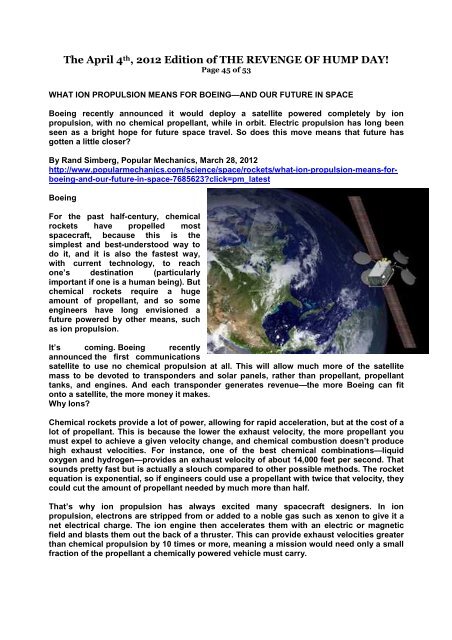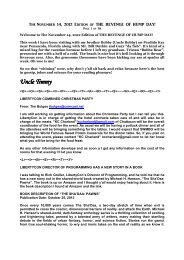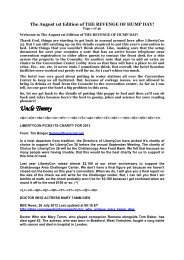Revenge of Hump Day 2012-04-04 - LibertyCon
Revenge of Hump Day 2012-04-04 - LibertyCon
Revenge of Hump Day 2012-04-04 - LibertyCon
- No tags were found...
You also want an ePaper? Increase the reach of your titles
YUMPU automatically turns print PDFs into web optimized ePapers that Google loves.
The April 4 th , <strong>2012</strong> Edition <strong>of</strong> THE REVENGE OF HUMP DAY!Page 45 <strong>of</strong> 53WHAT ION PROPULSION MEANS FOR BOEING—AND OUR FUTURE IN SPACEBoeing recently announced it would deploy a satellite powered completely by ionpropulsion, with no chemical propellant, while in orbit. Electric propulsion has long beenseen as a bright hope for future space travel. So does this move means that future hasgotten a little closer?By Rand Simberg, Popular Mechanics, March 28, <strong>2012</strong>http://www.popularmechanics.com/science/space/rockets/what-ion-propulsion-means-forboeing-and-our-future-in-space-7685623?click=pm_latestBoeingFor the past half-century, chemicalrockets have propelled mostspacecraft, because this is thesimplest and best-understood way todo it, and it is also the fastest way,with current technology, to reachone’s destination (particularlyimportant if one is a human being). Butchemical rockets require a hugeamount <strong>of</strong> propellant, and so someengineers have long envisioned afuture powered by other means, suchas ion propulsion.It’s coming. Boeing recentlyannounced the first communicationssatellite to use no chemical propulsion at all. This will allow much more <strong>of</strong> the satellitemass to be devoted to transponders and solar panels, rather than propellant, propellanttanks, and engines. And each transponder generates revenue—the more Boeing can fitonto a satellite, the more money it makes.Why Ions?Chemical rockets provide a lot <strong>of</strong> power, allowing for rapid acceleration, but at the cost <strong>of</strong> alot <strong>of</strong> propellant. This is because the lower the exhaust velocity, the more propellant youmust expel to achieve a given velocity change, and chemical combustion doesn’t producehigh exhaust velocities. For instance, one <strong>of</strong> the best chemical combinations—liquidoxygen and hydrogen—provides an exhaust velocity <strong>of</strong> about 14,000 feet per second. Thatsounds pretty fast but is actually a slouch compared to other possible methods. The rocketequation is exponential, so if engineers could use a propellant with twice that velocity, theycould cut the amount <strong>of</strong> propellant needed by much more than half.That’s why ion propulsion has always excited many spacecraft designers. In ionpropulsion, electrons are stripped from or added to a noble gas such as xenon to give it anet electrical charge. The ion engine then accelerates them with an electric or magneticfield and blasts them out the back <strong>of</strong> a thruster. This can provide exhaust velocities greaterthan chemical propulsion by 10 times or more, meaning a mission would need only a smallfraction <strong>of</strong> the propellant a chemically powered vehicle must carry.







